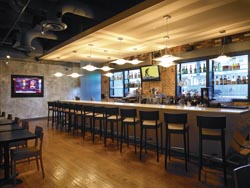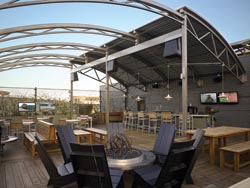Serving Up Entertainment

At the recently opened STATS restaurant, clients who come for a meal are invited to choose the game they’d like to watch at their table. Purpose-designed sports grills are giving customers the chance to choose their own programming, with a separate screen at each table.No other area of AV business has benefited more strongly from the flat-panel TV revolution than the restaurant market. With their narrow enclosure depth, ease of mounting, bar-friendly screen sizes and ever-increasing image quality, plasma and LCD screens have literally changed the face of modern American dining. Never mind the neon signs, the menus, the décor or the drinks behind the bar—the focus of visual attention in many of our restaurants today measures 16 by 9.
Of course, TV screens require content and, in huge numbers of bars, grills, brew pubs, and other quick-service establishments across North America, the programming that is prized above all else is sports. On one level, this can result in a single large plasma screen sitting behind a bar with low-level audio being played through a series of cheap-and-cheerful ceiling speakers. If you’re a customer and you want to watch a different game, you approach the bartender with cautious optimism and may, or may not, have your wish granted.
At the other end of the scale, operators of purpose-designed sports grills are giving their customers the chance to choose their own programming, with a separate screen at each table. In Atlanta, at the recently opened STATS restaurant (see separate sidebar) clients who have booked a table are invited to choose their game at the front desk.
“There are 20 satellite receivers that STATS can source from, along with multiple HD and Blu-ray DVD players,” said Bill Smedley, design and project engineer for the venue’s systems integrator, AVI-SPL. “On game days, they will have a guy come in early in the morning whose job it is to program all the sources and devices. He then gives the staff a menu card so that they can see what’s available—for example, the Falcons on satellite 5. The staff can then route that channel to each screen as customers request it.”
At STATS, Smedley and his team have deployed a Crestron Rack2 Dual Bus control backbone and provided each of the venue’s bars with its own WiFi touchpanel and wall-mounted docking station, with a further touchpanel located at the main video processing rack. A dedicated closed WiFi network is installed to support the use of the touchpanels anywhere throughout the restaurant.
The venue’s operator, Concentrics, insisted on HD video capability throughout the system and, with so much time and money invested in creating the right atmosphere, end-user control was a key issue. “We sat down and devised a control system that’s three layers deep, with each layer being password-protected” Smedley said. “The first layer is regular staff control with a local view monitoring table numbers, so that they can route any input to the table as the customers come in. The second level gives access for the management for assigning sources, as well as access to different audio inputs for routing to the various zones via the Biamp AudiaFLEX system we installed. The third level is technical service—that’s just for us.”
Menu Options
The more sophisticated restaurant AV becomes, the harder it is for non-technical staff to keep up. This in turn increases the risk that a venue’s mood may be adversely, if inadvertently, affected by the misuse of source selection or other parameters. Furthermore, the problem is not confined to restaurants that offer a wide variety of AV content—it might be a simple case of inappropriate sound levels, for example. In such cases, the solution need not always be as complex as the multi-layered Crestron control used at STATS.

At McGann’s Pub in Boston, Robert Soluri, president of local contractor Custom Cable Services, has given his client a cleaner control interface through the use of Symetrix Zone Mix 760 audio DSP architecture and ARC-2 interactive wall panels, a package that offers sophisticated processing such as ducking and automatic gain control, along with bulletproof reliability that resists the ‘improvements’ of well-intentioned but under-qualified establishment employees.
A daily selection of the top stories for AV integrators, resellers and consultants. Sign up below.
“I used to get service calls from McGann’s all the time,” Soluri explained. “They make a lot of their money charging admission to Setanta-televised games from overseas. If the system doesn’t work, it’s big trouble. They used to have a mixer that was forever getting messed with in ways that left the system ‘broken’ to anyone who didn’t know the ins and outs of signal flow. Now they can’t mess with it anymore! They’re totally happy to have Symetrix reliability and I’m glad to be doing other things on my Saturday mornings.”
In contrast to an operation like STATS, which was conceived from the outset almost as a temple dedicated to the integration of multimedia, small-scale restaurants such as McGann’s do not always see the value of such enhancements and, as a consequence, can constitute a tougher sell.
“The trick is selling them on the concept of a control system,” Soluri noted. “Since these businesses have a fleet of people around all the time, they think: ‘Why would I want to pay more money for a slick interface? My people can control it at the source for free.’ The trade-off, of course, is that if they can control it at the source, they can also break it at the source.”
Haute Cuisine
In the resorts and casinos of Las Vegas, budget is rarely an issue. Maria Cody, a Vegas-based senior sales director with AVI-SPL, is seeing venues on the Strip using “video projection, LED walls, and even Virtual Reality” to create a point of difference. “They are right at the cutting edge of technology because there is so much competition on the Strip, the operators know they need to keep investing if they are to stay one step ahead.”
Cody is keen to make a distinction, however, between those restaurants that are driven by visual impact and those—usually upscale—dining places that require a subtler mood. Or, as she put it: “There’s a difference between a venue where AV is used to create the atmosphere, and one where it’s used to enhance it.” In the latter, you are as likely to be given the chance to watch the Falcons as you are to be served a quarter-pounder from a polystyrene box.
“At high-end places, it’s all about the chef and the kitchen, and what they’re doing,” Cody pointed out, “and the operators don’t want their systems to detract from that. Their biggest consideration will likely be good sound quality, and a key issue there is sound masking. Some of these restaurants are right off the casino floor, and they don’t want the noise from the floor to be audible in the restaurant at all.
“In higher-end restaurants there is also huge emphasis on ambient lighting, so we have a role to play there in terms of control. Nine times out of ten they will have a lighting designer, and we will work with them to look at how the place will be run and then look at how it can be controlled. There may also be a video component, but it will be there to show artwork, not sports.”
Regardless of what the venue charges for its food or beverages, it seems that the march toward higher-quality audio and video is a relentless one that can only benefit contractors. Especially because restaurant customers of all shapes, sizes, and budgets are becoming accustomed to higher resolutions in other areas of their lives.
